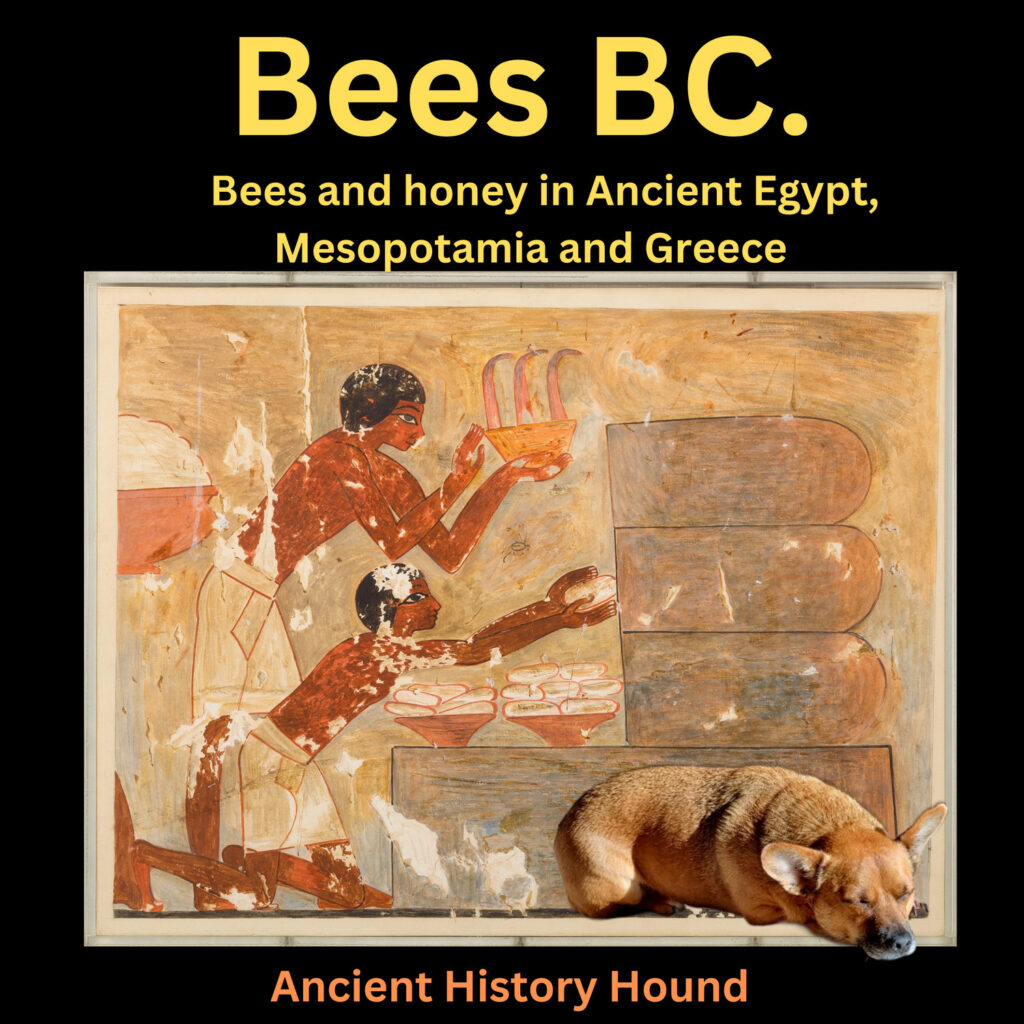I hope you enjoyed the episode and here is the extra content. I mentioned an episode all about Mad Honey at the end of it and here’s a link to it.
https://ancientblogger.libsyn.com/mad-honey
Images.

Below is a diagram of the earliest depiction of apiculture in Egypt. Here’s a good site with a bit more about it and some other examples.


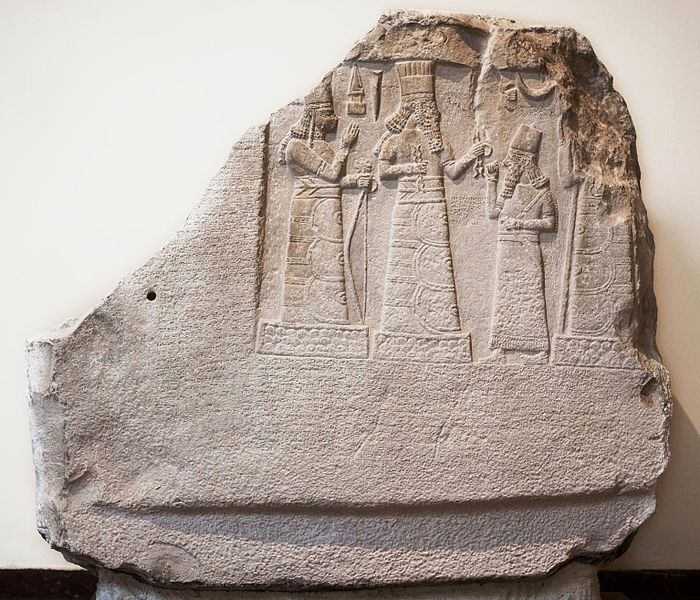
Shamsh-res-usur and the stele where he boasts of his honey prowess.
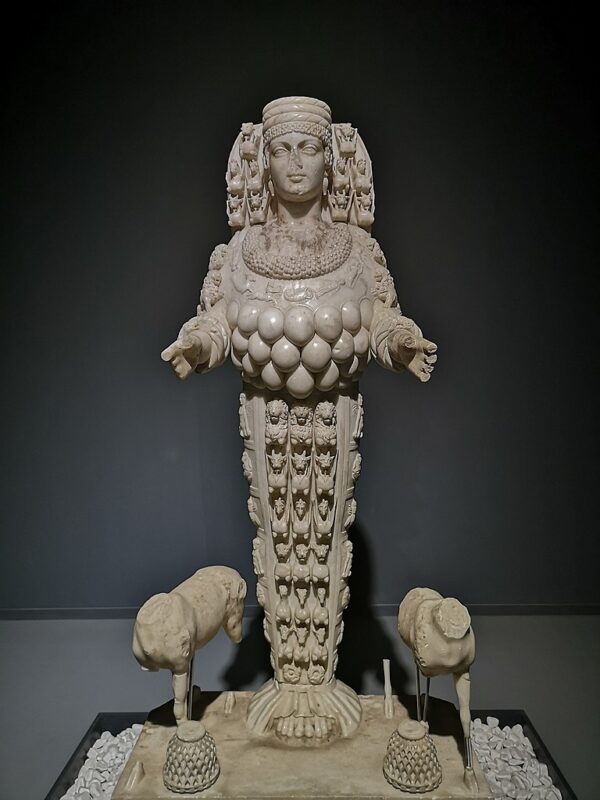

Some beehives.
Here’s an article on the copies of the two Greek behives I mentioned. The images are from the article.
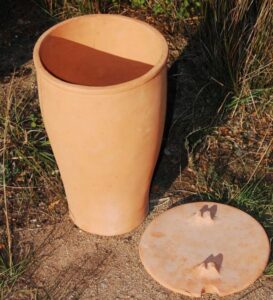
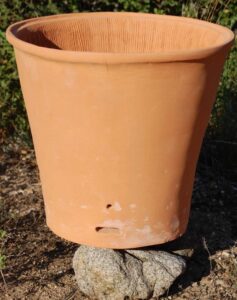
I mentioned Semonides – so here’s a link to his types of women, and here’s a piece I did about Mesopotamia and another animal, the camel.

Reading list.
D’Agata, A & De Angelis, S. Minoan Beehives. Reconstructing the Practice of Beekeeping in Bronze Age Crete
Deliyannis, M. Tsatsarou, E. Tsapi,G & Gousiaris G. Kings and queens of the bees in the literary and the scientific tradition
Demirel, S. Apiculture in Hittite cuneiform texts
Giannas, C. Beekeeping practices in Agathonisi during antiquity
Hammad, M. Bees and Beekeeping in Ancient Egypt.
Kalogirou,K & Papachristoforou, A. The construction of two copies of ancient Greek clay beehives and the
control of their colonies’ homeostasis
Karatasios, I & Triantafyllidis, P. Production Technology of the Ancient Terracotta Beehives on Milesian Agathonisi
Island.
Kritsky, H. Ancient Beekeeping in Egypt.
The quest for the perfect hive: Ancient Mediterranean origins
The Tears of Re, Beekeeping in Ancient Egypt
Mazar, A. The iron age apiary at Tel Rehov, Israel
Mazar, A & Panitz-Cohen, N. It is the land of honey: beekeeping at Tel Rehov.
Mazar, A. Panitz-Cohen, N. Bloch, G. The Apiary at Tel Rehov An Update
Metwaly, A. Ghoneim, M. Eissa, I. Elsehemy, I. Mostafa, A. Hegazy, M. Afifi, M. Deqiang, D. Traditional ancient Egyptian medicine: A review
Smith, L. The Kahun Gynaecological Papyrus: ancient Egyptian medicine
Skarmintzos, S. The cult of Artemis in Ephesus and the possible explanation of the bee symbol
Transcription.
Besting your forefathers, politics and hive designs. Join me as I talk about bees and honey in antiquity on the Ancient History Hound podcast.
Hi and welcome, my name’s Neil and in this episode I’m turning the clocks back in more ways than one. Roughly 6 years ago I decided to start a podcast. Originally it was called ancientblogger’s podcast which I then rebranded to Ancient History Hound. I think the title is a bit clearer about what it’s about.
What I have done is rewrite and re-record the first episode I ever did which was on bees and honey in antiquity. Initially I thought it would be a simple job, however, that was not the case. As mentioned I have rewritten much of it with a lot of new content.
In the episode I will discuss how honey was made, in short apiculture, in Egypt and Mesopotamia before finishing with the Greeks who, as ever, have a lot to say about it all. In case you’re wondering why I haven’t included Rome, well there’s only so much I can cram into an episode so perhaps in the future I’ll do something just on them. That feels a very Roman way to do it.
I would like to say thanks for the nice emails I’ve received and reviews. Don’t forget you can leave a reivew on Apple and Spotify for the podcast as well as individual episodes on Spotify. If you listen through any other platform feel free to rate or review if you can – I say it every time but it really helps with getting more visibility.
There will be episode notes on ancientblogger.com, that’s my website, with a transcript, some of the images I talk about and anything else I think will help. This includes a reading list of the sources used and cited. If you want to find me I’m on X as ancientblogger and houndancient for the podcast and as ancientblogger on youtube, instagram and tiktok. It’s all ancient history content there as well.
Now there are a couple of tales about honey in antiquity which I’ve covered in the minisode ‘Mad Honey’, safe to say that it wasn’t always a good idea to take honey for granted. So if you want to hear about that then you can easily find it – it’s a minisode so short and sweet if you’ll excuse the pun.
Right then, I’ll begin.
The earliest evidence of a person collecting honey, at least in terms of an image, is found on a cave near Valencia in southern Spain and dates to 8,000 BC. The image is a simple one, a figure holds onto some vines with their left hand with an object in their right hand. Around them are bees. It’s more probably that this was a person collecting wild honey, that is to say a nest which had grown naturally and not as the result of a man-made hive.
It makes absolute sense that people back then, as I’m sure they do today, would have chanced their arm, literally so, collecting the sweet stuff and perhaps suffering a few stings for their effort. In order to find the earliest instances of apiculture, that is humans keeping bees, we need to move forward a few thousand years and travel east to the other end of the Mediterranean.
We start at Egypt and at a temple to Ra which was built by a Pharaoh called Nysurre Ini. His rule dates to around 2,500 BC and the temple was one of many buildings be constructed, including three pyramids and to get some perspective using pyramids the famous Great Pyramid at Giza had only been built 100 years or so previously.
The temple to Ra featured many reliefs and in one of them we have a scene which is the earliest known where honey is being farmed. On the left a figure crouches next to what looks like a wall with small indents in it, we’ll come to that in a moment. On the right of the scene other figures stand and are pouring what is presumably honey into containers. A large bee hovers nearby.
The crouching figure at the far left is attending hives, and here we meet our first thing of note. Hives for much of antiquity were horizontal cylinders. Though there was a variation of this which I’ll come to later. The premise of the horzinotal type was simple – a cylinder with a hole in one end for the bees and a lid at the other which could be removed and which allowed the worker to access the honey. Unlike the figure in the cave here we can be sure that a process was in place which allowed people to harvest honey. The fact that it was in a temple to Ra is also apt, according to myth bees were formed from the tears of Ra.
We meet a more spectacular depiction around a thousand years later. It was found in a tomb but not of a Pharoah, instead a governor called Rekhmire. Perhaps that undersells Rekhmire, he wasn’t an average official but a very senior one and his tomb showcased his many, many titles.
The scene, one of many in the tomb, features two individuals. One kneels and another stands over them. Both face three unsual shaped objects, they are stacked one upon the other and look like cylinders cut in half. That is to say one end is rounded and the other is a flat vertical front. You’ve probably worked out as per my comment a moment ago – these are the hives, and the kneeling figure is removing small oval objects from the hive and placing them in a bowl. These are honeycombs.
The figure standing up holds a bowl and the artist has painted wafts of something coming up from it. This has been suggested as an incense burner and from this it’s been posited that this was acting as a smoker. Now it makes sense, one person collecting and the other lulling the bees whilst they do so. A very interesting argument has been made on the back of this, namely that the act of smoking bees which is done to calm them down, may have evolved from the act of burning incence as an act of reverance to the bees. The docile behaviour of the bees was understood as the bees accepting and being pleased by the offering. The argument then speculates that this was a possible origin for how smoking came to be.
Given that an object identified as a smoker has been found in central Greece and dates to around 3,300 BC it’s likely that this was a strategy used long before the relief depicted it. It’s entirely plausible that it preceeded apiculture and perhaps the Egyptian act of smoking bees was entirely aligned with their view of the bee as holding some divine status, or at least to respected.
By the time of Rekhmire apiculture was big and important business in Egypt and the roll call of officials responsible goes some to way to underline this. As far back as the first dynasty, a period from 3100 BC to 2686 BC the fantastic title of ‘Sealer of the Honey’ was used. Nysurre Ini had an individual called Nykara serve under him who was called ‘the Overseer of all Beekeepers’.
‘Chief Beekeeper’ and ‘Kings aquaintance’ was inscribed on an scarab seal, dating to some time around 1,800 BC, which belonged to a person called Intef. This small object goes someway to evidence the bureaucracy within the industry.
And of course there were the scenes on the tombs mentioned. These don’t just show honey being collected as a singular event. Instead the scene is set within the context of what we might realise as a supply chain. It was collected, sealed, stored and then presumably moved to locations where it was used.
The uses for honey at this time were numerous, obviously there was the taste. It was a natural sweetener and I’m very partial to a dab of it in my coffee, not too much though – just in case my dentist is listening. However, there was one major use of it in ancient Egypt. Medicine.
The ancient Egyptians were renowned for their medicinal skills and honey formed the basis of many treatments. The Kahun, Ebers and Smith Papyri documented over 900 treatments and 500 involved the use of honey. Take, for example, the use of honey as a contraceptive when mixed with natron and crocodile dung. This instance is one of the more well known examples and was recorded in the Kahun papyri wich dates to 1,900 BC. The Ebers and Smith papyri date a few centuries later and here honey was used to treat wounds, something which honey is well suited to do – though please don’t try that at home. Other uses related help respiratory problems, digestive issues and even parasites.
Thinking about it honey must have seemed a wonder. It could be used for pretty much anything. Even a side product, beeswax, had uses, from a binding agent on bandages to giving a wig perfect curls.
The ancient Egyptians weren’t the only people to realise how useful honey was and one of their great rivals, the Hittites, also took it seriously. These were a people who rose from their base in what is modern day central Turkey to form an empire which expanded down the Levant, covering parts of modern day Syria.
References to honey are largely contained in the writings of the Hittites, specifically their cuneiform tablets. In tablets dating from 1650-1500BC the market value of honey was established as well as the penalty for stealing hives. This was now a fine of 6 shekels of silver but previously it had been punishment by beestings. Hittites used honey, much as the Egyptians did, as a sweetener. It was added to wine and beer and along with olive oil made a basic sauce for frying meat in. It was also present in at least 13 types of bread.
Honey was burnt as a fragrance and used for ritual purposes. A newborn baby would have its tongue wiped with honey to get rid of a curse and it was further used in other purification rituals.It was even used to tempt a god to their respective temple by being mixed with other ingredients and spread on the roads leading towards it. The relationship between honey and the divine didn’t stop there, according to one myth the mother goddess Hannahanna sent a bee to find her son which it successfully did, even stinging him into returning.
So far we have seen that the Egyptian and Hittites viewed honey as a needed commodity and one which they had both created infrastrutures to support. What we lack at this point is something more tangible, something which can evidence how it all worked and at a site in modern day Israel we have just that.
The site is known as Tel-Rehov and is found in the Jordan Valley. It occupied a strategically important location, both on the north south route and an east-west route. This was no backwater and by the 10th century BC had grown to become a major city controlled by Egypt. It was here that an apiary was discovered and this consititutes some of the oldest finds we have for hives and honey production.
The apiary itself is within a collection of smaller buildings which presumably facilitated the production and storage of honey. However, the area where the hives were found was 1.5 metres lower than the surrounding rooms and it’s been speculated that this was to help keep the bees away from the other rooms and the nearby buildings. This wasn’t a rural facility, it was slap bang in the middle of other buildings.
In the lower area the cylindrical hives were arranged in three parallel rows, each row formed of at least three tiers. The rows had two aisles between them, 1.2 metres and 1.85 metres. Perhaps think of a supermarket with shelves and aisles, it was something like that.
The hives measured eighty centimetres in length with a diameter of 40 centimetres this gave them a volume of 56 litres. Each had one end with a small hole, between 2-4cm wide which allowed the bees in and out. The other end had a lid with a handle which would be removed so the honey could be gathered. Now there was some real ingenuity here because the hives on either side of one of the aisles faced with their lid-ends inwards, this meant that workers in that aisle could access the honey from the hives either side of them.
There’s evidence that the hives were covered but this area doesn’t seem to have been roofed, which makes sense given that the bees would be flying about.
Not all the hives were found, the site seems to have been partially destroyed in the 9th century BC. However, it was estimated that 180 hives could have been in place here and from this we can start to speculate on how much honey was produced. The estimates are that each hive could have supported 10-15,000 bees and could produce between 3-5 kg of honey a year with between 0.5 and 0.7 kg of beeswax. Even with the middling figure of 100 hives that’s 300-500 kg of honey a year. A huge amount and one which can only evidence an industry level output. The fact that the apiary was within the ciyt, not outside of it, also points to the value. Presumably this location kept it secure. We might now reason that the lowered floor here acted in a way to focus the bees rather than have them flying about too much.
In following work at the site there was a discovery with huge implications. Within one hive pieces of a bee were found within some charred material. A session with an electron microscope later the species of bee was identified as the Anatolian honeybee. In many ways this makes sense, the Anatolian honeybee is not very aggressive and very productive, today it’s the backbone of the Turkish honey industry which is second only to China in honey production worldwide.
The curious part of this, as you may have noted, is that the Anatolian Honey Bee wasn’t native. The local variant, the Syrian honey bee is apparently less productive and more aggressive. So it made because, well, more productions presumably fewer stings in that built up area. But also, imported? Did this mean that this sort of thing could happen, that apiculture was advanced to the level that non-native bees were picked ahead of the native ones and then moved perhaps hundreds of miles to a site? If so then this evidences a high level of apiculture.
And this level of aptitude in apiculture was something you might want to boast of, on a Neo-Assyrian stele dating to the mid 8th century BC a ruler of Suhu, an area in Mesopotamia, boasted how he had reared bees for honey – something his forefathers had not been able to do. The ruler, an individual called Shamash-resh-usur, went so far as to state that he had brought the bees from Habhu and this has been argued as within the Zagros mountain in Iran or the eastern Taurus mountains – this was a distance of 400 Km. So perhaps there was a separate import/export industry for bees at this time.
Mesopotamia had also been utilising honey for some time. In the Epic of Gilgamesh which dates to roughly 2,100 BC the eponymous character offers honey to the gods when his comrade Enkidu dies. Perhaps though, as per the previous example, apiculture was a bit more sporadic. And this comes with the caveat that Mesopotamia was an area in which empires waxed and waned, I appreciate that it’s unfair to give an over generalising comment. It’s plausible that apiculture wasn’t as much of a thing here as it was elsewhere because the landscape didn’t support large hives. As has been noted, the large plain areas don’t seem condusive to honeybees.
We can therefore consider the boast of Shamash-resh-usur in this context. That is to say that apiculture wasn’t something easily done. It wouldn’t make sense for Shamash-resh-usur to cite this achievement if apiculture was a common thing there. That wouldn’t have made sense.
The final culture of people I am going to discuss are the ancient Greeks and it’s fair to say that they had a lot to say about both bees and honey.
I’ll start with mythology and the Thrai, these were three sisters, minor divinities – perhaps nymphs, who had wings and ate yellow honey which afforded them the gift of prophecy. They lived on mount Parnassos and would fly about presumably offering their insights.
Honey wasn’t just used in myth as needed foodstuff for prophecy, when Zeus was an infant he was hidden from his father in a cave on Mount Ida in Crete. Here he was cared for by nymphs with goat milk and honey. According to Diodorus Siculus, who wrote in the 1st century BC, Zeus rewarded the bees by changing their colouring to what we know today. Sadly Diodorus didn’t mention what the colours of them were pre-makeover. The nymphs who had cared for Zeus were daughters of a character called Melisseus. The name Melisseus translates along the lines of ‘bee-man’ or ‘honey man’.
With the Thrai and Melisseus we have deities associated with the bee in some way, but for the ancient Greeks there needed to be a mediating figure, someone who taught the ancient Greeks the art of beekeeping and this character was Aristaeus. His name translates as ‘most useful’ or ‘most excellent’ and this is very much the case because Aristaeus was very versatile. His main role seems to have been a god of shepherds but he also taught the arts of cheesemaking and cultivating both olives and hives. He was pretty much the expert in rural living.
The Greeks seemed to have woven aspects of bees and honey readily into their myths, and at one site this was manifested further. I’m talking about Ephesus.
Ephesus sits in the west of modern day Turkey, though it is now 6 km or so from the Aegean sea it was once a coastal city. Founded around the 10th century BC it was most famous in antiquity for its association with Artemis and in 550 BC a wonder of the ancient world, the Temple of Artemis was built there. It hadn’t been always the case, an earlier deity, Kybele, seems to have been the previous deity worshipped there. So began a process common in antiquity where one deity slowly replaced and was morphed into another. This was made easier in some regards as Artemis and Cybele shared some aspects, such as the close association with animals and motherhood, even though Artemis was a virgin goddess. And it’s worth pausing at this point to mention that deities often had different representations. Though the virginity element of Artemis was central she was by no means the tennager on tip toe with a hunting bow which is often the image served up. At Sparta, for example, her worship could involve human blood and in myth she’s linked to human sacrifice in some myths. If you wanted to learn more about this you can listen to Dr Carla Ionescu talk about her on an episode all about Artemis.
At Ephesus the bee became an integral image, it featured on their coins and even entered the lexicon of the priesthood there. In Aristophanes’ comic play Frogs the poet Euripides mentions the bee-nuns of the temple of Artemis. We might think of them as priestesses and they were known as Melissae, or honey bees.
One argument even suggests that the famous statue of Ephesian Artemis was linked to bees. If you’ve not seen it’s instantly recognisable. Artemis is flanked by two animals and she stands with her hands oustretched. Around her midrift are rows of small globes. It’s been argued that these are breasts, alternatively bulls testicles have been suggested. Hower, it’s been posited that they represent or reference a wild honeybee nest. The idea behind this is that at some point the votive figure for Artemis would have been a simple wooden one, this was common in ancient Greece. Large marble statues weren’t a regular thing.
The argument supposes that wild bees attached themselves to the idol, a perfectly feasible event and a nest resulted. The Greeks would not have likely removed this, instead perceiving it as divine approval. So it goes that the later globes are a reference to this, perhaps by this point the specific rationale forgotten but still passed down as part of the original representation of Artemis there.
The bee wasn’t just linked to Ephesus, elsewhere in Greece it was an animal with many connotations. Often good, but also not so good. Take this early example from the archaic poet Hesiod. In his work Theogony the poet compared the hard labour of a bee and the lazy parasitic nature of a drone to men and women. In fact I’ll go ahead and quote:
“all day long until the sun goes down the bees are busy laying the white combs, day after day, while the drones stay indoors in the covered hives and reap the toil of others into their own bellies – so did Zeus who thunders on high make women to be an evil for mortal men, grevious partners”.
The bee could represent more than the divine, it could be a way of commenting on the social and the political, usually at the expense of women. In the political sphere the dynamics of a hive might be understood and perhaps not fully welcomed. In the play Persians, Aeschylus had the Persian soldiers akin to bees and Cyrus as the king bee. The setup of a hive, a number of workers who had no say with one single individual in charge, must have rankled. It was too much like a monarchy, something Athens of the Classical period wouldn’t have been much drawn to. In Plato’s republic the drone is again mentioned, this time its compared to the useless element of society and the concept of the hive and honey is almost turned upside down. The son of an oligarch might turn into a democrat if he sups on the honey of the drone. Here we have sweetness and honey as a dangerous indulgent thing.
But of course there could be no doubt that hives functioned effectively and in Xenophon’s Oeconomicus we find the bee as an aspirational figure, albeit one for a wife. If a woman became a Queen bee the househould would run very productively. She would ensure that the slaves worked properly and the house would benefit as a result.
It wasn’t just Xenophon who held the bee in high regard and as a role model for women. The Archaic poet Semonides of Amorgos wrote a poem describing the different types of women. Each was linked to an animal and it’s safe to say it has not aged well.
It’s possible that the poem was deliberately offensive, possibly for a ritual. Alternatively it could have been written as a satire, a sort of Archaic roast. However, it’s far more likely that this was just in line with what others such Hesiod thought of women. Remember that Hesiod was writing at a similar point in time.
According to the poem that man who has a wife akin to a bee is the most fortunate, he will have a bountiful household and handsome children. In addition his wife won’t be the type to hang around with other women gossiping about intimate stuff. The other types of women, from those akin to the weasel through to the ape do not have much in the way of anything resembling a compliment. Semonides, it’s safe to say, wasn’t a fan of women in any context. Moving swiftly from one Archaic poet to another there is a reference by Plutarch, albeit with the caveat that this is Plutarch writing many centuries later, involving Solon and bees.
Solon was a reformer of ancient Athens who was brought in to solve a crisis which was occuring there in the early 6th century BC. I talk about what he did and the challenges he had in the episode on Democracy. In short he tore up the social and political rulebook and wrote a new one which covered a range of topics. One of these, as Plutarch wrote, was that hives had to be 300 feet from your neighbour, or possibly your neighbour’s hives.
It might be that this was something Plutarch invented, but it feels believable. If honey was an important commodity then it would make sense that those involved in producing it would need some form of regulation. It’s not as if we haven’t had evidence of beekeeping and rules prior to this and at one location in Attica, the region Athens controlled, we have boundary markers and land renowned for bees.
The mountain range of Hymettus is to the east of Athens and it was here that markings dating to the 4th century BC were cut into the bedrock. The hills of this mountain range were famous in antiquity for producing the best honey money could buy. Though no hives have been discovered there it’s plausible that hives were situated, perhaps temporarily and within the designated areas. Again this is speculative, but we know that boundary markings were made here and that the area was pefect for bees. So why not?
We hear of honey in the plays of Aristophanes who noted that the Attic stuff was really expensive and that it was useful in keeping screaming babies quiet. He also mentioned honey sellers and according to an inscription dating to the 4th century BC we even know the name of one individual, a woman called Piloumen who sold honey. We might think that the production of honey and its distribution involved various people in Athens at different strata of society.
Though Athens doubtlessly cashed in on the honey trade it wasn’t the only place. Travelling east across the Aegean sea is the island of Agathonisi. In antiquity it seems to have been known as Tragia, both Thucydides and Strabo use this name and this was due to the large goat population there. On the north of the island is the site of Katraki, a fortified position dating to the late 4th century BC at the earliest and here a number of hives were found. Archaeologists also discovered extension rings, these are extra rings which could be used on the horizontal hives to extend the hive and increase the honey produced. One estimate in the study I’ve included in the reading notes about this came to 1,000kg of honey a year alone facilitated just by these rings.
Some measurements of the hives were able to be taken and indicated a hive of around 40cm in length with a rim diameter around the same size. The tubular design wasn’t consistent and often narrowed in the the middle. Though these dated to the 4th century BC at the earliest there have been hives discovered, such as the one at Vari in Attica which was similar in size and shape. But what was found here was a different type of hive, a vertical one.
These resembled baskets or very big plantpots, there was a range of height, from 29-45cm high and all had narrower bases. The bees were able to enter through a narrow hole near the base and the lid was removable, perhaps being made of wicker or other materials. This type seems less common in ancient Greece, there have been others like it found at Isthmia in central Greece and date from the 3rd century BC. One suggestion is that this type didn’t need to be stacked. It could be placed at an opportune spot and then removed. These also had markings on them, either denoting the owner or the potter. Though one argument is that the wording found reads ‘public beehive’ which presents a number of tantalising prospects.
These findings illustrate an issue in trying to form a clear picture about beekeeping in Greece, namely that there is a reliance on a very perishable material to give us information. Pottery was famously reused one apt instance is the use of two cylindrical beehives being placed with their lid-ends together to form a makeshift coffin for an infant at Marathon. But also pottery was smashed and wasn’t something which survived easily.
And here it’s worth mentioning the Myceneans, a people of ancient Greece in the 2nd millenium BC. This was a hugely important civilisation in the Aegean and would doubtlessly have practised apiculture, perhaps adopting what had been happening at Egypt. The difficulty is finding much to substantiate how it manifested exactly. One set of vessels found on Crete have been argued as
vertical beehives and so perhaps these were more popular than we think. And here we meet the problem of relying on evidence which was unlikely to survive. As an example it’s thought that wicker baskets were originally used and the ceramic vertical hives, the basket types, were just a more permanent version. Wicker and pottery, not the most durable of materials. – without more evidence we can only speculate and move between points in time where we have something tangible. A sort of joining the dots across large spans of time.
You might be wondering about ceramic hives and how good they were. Were they too hot or too cold? This was something the later Roman writer Columella considered before reasoning that ceramic hives weren’t actually that good. However, modern experiments using this material and a colony of bees in both types of beehive has resulted in a strong thumbs up. The hive in each was able to regulate temperature with no issue, but then even without this there is all that history of this type of hive being used for many centuries previously. Perhaps it was just a case of Rome being, well a bit Rome about anyone else and especially the Greeks.
A writer who was a bit more accurate about things related to bees was Aristotle. In his work concerning animals he made a number of observations including how bees carried ‘bee-bread’ on their legs and how the hive is formed of wax cells. Aristotle noted that the King bee only left the hive during a swarm, you might not be surprised that the idea of a Queen bee hadn’t yet been noted. In fact Aristotle goes as great length to describe the structure of the hive and the division of work. He even wrote the types of danger a bee or hive might be in from disease, birds predating on the bees and even the toad which apparently loved eating bees and was the scourge of the bee-keeper.
In terms of the production of honey Aristotle noted the different types of it and reckoned a hive could supply 6-9 pints of honey with an excellent hive offering up 12 or 15 pints. Though a range of plants were noted as supporting hives thyme seems to have been a very popular one. Aristotle mentioned it and it was featured in Theophrastus’ On Plants – a famous work in antiquity. Here the importance of thyme was noted, not just for it being a favourite of the bee but also that bee keepers would know how much honey to expect based on how well the thyme in the area flowered.
And with that I come to the end of this episode. I hope you have enjoyed it and feel free to get in touch and say hi. More importantly, and as ever, keep safe and stay well.

